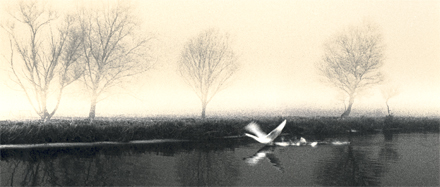Can a photograph be a work of art?

Is photography art? This old chestnut has been around for as long as photography. Now that the most prestigious museums and galleries around the world have extensive collections of photographs, is the question finally answered? I think so in the positive sense that what could be regarded as simply a skilled craft leads to an artistic outcome. But can a photographer ever truly be an artist? Is the artwork made in the camera or in the darkroom? This question is further complicated these days with the advent of digital photography and the accompanying software that allows the manipulation of original images.
Henri Cartier-Bresson
Cartier-Bresson, one of the twentieth century’s most respected photographers had all his prints made for him, so is his work of less value than a photographer who spent hours in the darkroom? What of monochrome versus full colour work? Some critics and photographers believe that the only work to be taken seriously is monochrome. Why?
I apologise, for so far it seems all questions and no answers. So how does the argument progress; a photograph can be a work of art but a photographer cannot be called an artist as per the dictionary definition. But my view is that a good photographer is as much an artist as Tracey Emin or Damien Hirst.

Alfred Stieglitz
Stieglitz, a pioneer of photography at the end of the nineteenth and the beginning of the twentieth century, struggled to get the medium taken seriously by the art establishment in America. Stieglitz said: “Artists who saw my early photographs began to tell me that they envied me; that they felt my photographs were superior to their paintings, but that, unfortunately, photography was not an art.”
Bearing that in mind let’s examine what artistic input there is in creating a photograph. It is comparable to a painter composing a work in all respects. The photographer finds a subject, composes the picture (tries to envisage how it will appear on the paper) considers the light intensity, and direction, highlights and shadow areas and in 125th of a second records the scene on film. That image is then an exact record of that moment in time. Time is frozen in that image and the scene will never be replicated again. The painter benefits from greater freedom of course. Yes, the skill of the great painter has to be present, but he can cheat. The painter can alter that scene at will as he applies his paint to the canvas.
If you try to compare major paintings with great photographs you may well be ridiculed. How can you compare Pablo Picasso’s Guernica – regarded as one of the most important depictions of a despicable act of war – with Don McCullin’s, Albino Boy, Biafra 1967 or The Grunt, Vietnam 1968? I would suggest that they have equal merit. They could hang together on a gallery wall with equal validity; a testament to the folly of mankind.
Don McCullin
I would like to talk briefly about McCullin. His work is acknowledged to be of huge importance and many photojournalists regard him as the most accomplished war photographer of the twentieth century but his work was shunned for years by the Imperial War Museum in London. If you made an enquiry of the museum you would be told: “I regret that there are no photographs taken by the photographer Don McCullin in the collection, nor is there any ephemera relating to his work. This museum is an archive for official photographs and since Mr. McCullins’ relationship with authority is tempestuous to say the least, he has not been commissioned to work in an official capacity.” And indeed he never has been, being completely ignored by the government at the time of the Falkland’s war. The Museum authorities have relented in recent years with exhibitions of his work being staged.
What of other photographers’ work; Adams, Avedon, Capa, Brandt, all in museums and private art collections all over the world? How do other photographers fit into the world of art? Some are famous for photographing beautiful women in the finest clothes, or film stars and members of the royal family. What of the photographers who work on the National Geographic magazine who have over the years taken incredible pictures of the life forms and geography of our planet?
What do you think? If you would like to contribute to this discussion please do so or indeed contribute on any facet of photography.
Create some income from your photography hobby.
Bibliography.
Don McCullin. Unreasonable Behaviour – An autobiography. Highly recommended; a great read.
The Print. Time Life Books.
One thought on “Can a photograph be a work of art?”
I believe that it is… Several people may see the same image or view but only a skilled photographer could capture it in a beautiful or special way.Indeed a gifted photographer will see a great shot where others see only an average view. I find photographic exhibitions equally as interesting and impressive as exhibitions of paintings – just a different art form.